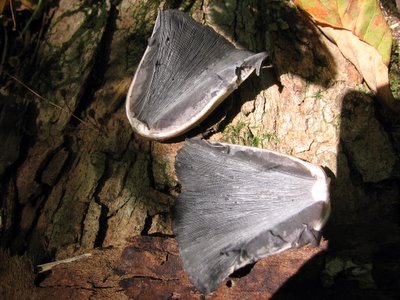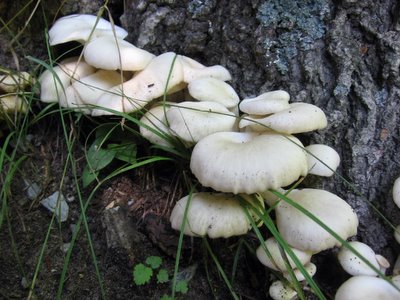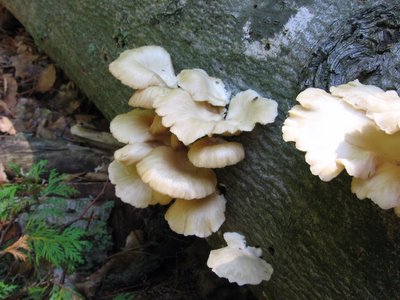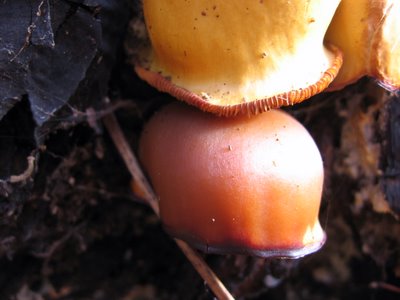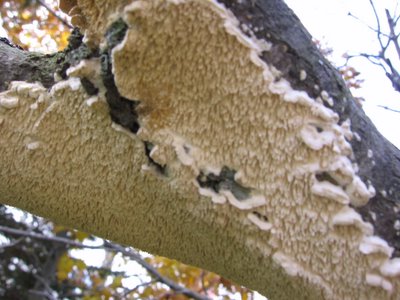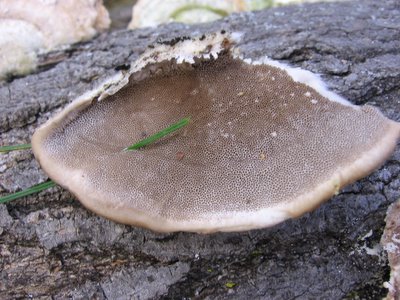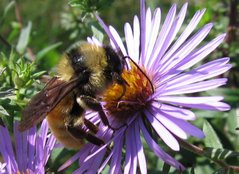Tuesday, January 31, 2006
Monday, January 30, 2006
Leccinum griseum


18 September, 2005
I've tried many times to identify this Bolete, without success. The cap is 80 mm in diameter. The stalk is thick and seemed to be hollow. I didn't get a spore print. You can see from the picture of the pore surface that it seems to stain a yellow/green. I've come across a very interesting book for identifying Boletes: "North American Boletes". Unfortunately it costs $111.95! The purchase of this book would allow me to upgrade my status from hobbyist to amateur Naturalist. While this is appealing there are certain countervailing forces...
(Update 3 February, 2006)
In looking at David Arora's book, Mushrooms Demystified, I believe that this Bolete falls into the Leccinum family. These are rough-stemmed Boletes. You can see in the bottom picture that the stalk is scabrous. Now looking at Bessette, Bessette, and Fischer, Mushrooms of Northeastern North America, and using the key for Leccinum this mushroom seems to key out reasonably to L. griseum: "pores surface white, typically staining greenish then slowly dingy yellow when bruised; cap yellow brown to brown when young, becoming olive-brown to grayish brown at maturity."
I've tried many times to identify this Bolete, without success. The cap is 80 mm in diameter. The stalk is thick and seemed to be hollow. I didn't get a spore print. You can see from the picture of the pore surface that it seems to stain a yellow/green. I've come across a very interesting book for identifying Boletes: "North American Boletes". Unfortunately it costs $111.95! The purchase of this book would allow me to upgrade my status from hobbyist to amateur Naturalist. While this is appealing there are certain countervailing forces...
(Update 3 February, 2006)
In looking at David Arora's book, Mushrooms Demystified, I believe that this Bolete falls into the Leccinum family. These are rough-stemmed Boletes. You can see in the bottom picture that the stalk is scabrous. Now looking at Bessette, Bessette, and Fischer, Mushrooms of Northeastern North America, and using the key for Leccinum this mushroom seems to key out reasonably to L. griseum: "pores surface white, typically staining greenish then slowly dingy yellow when bruised; cap yellow brown to brown when young, becoming olive-brown to grayish brown at maturity."
Thursday, January 26, 2006
The camera is fixed!

It was a pretty sad day for birding over at the Point today. Long stretches of nothing punctuated by aggressive Chickadee attacks. We're going to need a stategy to get through this winter. Going to have to spend some quality time over at the Firefly Forest Blog. It's eternal summer over there.
Wednesday, January 25, 2006
Gulls in January
In doing a Technorati search of references to Gulls in blogs during this past month I came across the following entries:
1. In Border's Birds I found a picture of a Black-headed Gull. Border's Birds is a new blog from the UK, "A Diary of the Birds Visiting a Rural Garden in the Scottish Borders." The Bird Woman already has many beautiful pictures of birds posted on the blog.
2. earth home garden is also a new blog that I've discovered through this search. Here is a picture of a California Gull. This is a fascinating blog by a couple that is seeking to live out an ecologically faithful life in a mountain cabin. Beautiful pictures and commentary.
3. Here's a Glaucous Gull over at the Flycatcher, another interesting blog I came across today.
4. A Black-headed Gull in flight over at The Hornet's Nest (Warwickshire, England).
5. Ring-billed Gulls featured at A DC Birding Blog. I discovered this great blog a long time ago (in Blog time, that is).
6. The BBC News reports a rescued Herring Gull that got caught up in a shoplifting drama.
Birding on the Internet! You've got to love it! Still waiting for my camera to be diagnosed and fixed.
1. In Border's Birds I found a picture of a Black-headed Gull. Border's Birds is a new blog from the UK, "A Diary of the Birds Visiting a Rural Garden in the Scottish Borders." The Bird Woman already has many beautiful pictures of birds posted on the blog.
2. earth home garden is also a new blog that I've discovered through this search. Here is a picture of a California Gull. This is a fascinating blog by a couple that is seeking to live out an ecologically faithful life in a mountain cabin. Beautiful pictures and commentary.
3. Here's a Glaucous Gull over at the Flycatcher, another interesting blog I came across today.
4. A Black-headed Gull in flight over at The Hornet's Nest (Warwickshire, England).
5. Ring-billed Gulls featured at A DC Birding Blog. I discovered this great blog a long time ago (in Blog time, that is).
6. The BBC News reports a rescued Herring Gull that got caught up in a shoplifting drama.
Birding on the Internet! You've got to love it! Still waiting for my camera to be diagnosed and fixed.
Saturday, January 21, 2006
Russula unidentified
Apocalypse Now
This morning it was pouring rain. Now, at 1100 hours, it is snowing heavily. The snow is coming down in huge (and I mean HUGE) white fluffy flakes. This afternoon is supposed to be sunny and plus six degrees Centigrade. This is January! This is Canada! What is going on? Its hard to believe that we have another three months to go before the birds begin to return and the mushrooms come up. At least this gives me time to get my camera back up and running. I accidentaly crushed the lens back into the camera when I bent over to look at a bee in the snow. It was so unusual that I wanted to take a picture of it for the blog. After the camera broke I then came across two spiders in the snow. I don't ever remember seeing that before. Well, in the meantime I will continue to try to identify the mushrooms and plants that I took pictures of last season.
Tuesday, January 17, 2006
Pholiota squarrosa


21 September, 2005
I have many good pictures of mushrooms that I have not yet been able to identify. This identification took about two hours to make. There are so many different kinds of mushrooms and each species can appear very different from instance to instance and each guide only covers a certain cross section of the species. At least I can be thankful that I'm not studying beetles... yet.
I have many good pictures of mushrooms that I have not yet been able to identify. This identification took about two hours to make. There are so many different kinds of mushrooms and each species can appear very different from instance to instance and each guide only covers a certain cross section of the species. At least I can be thankful that I'm not studying beetles... yet.
Thursday, January 12, 2006
Wednesday, January 11, 2006
Christiansenia mycetophila, Gymnopus dryophilus
10 August, 2005
Christiansenia mycetophila (Collybia Jelly) attacks the gilled mushroom, Gymnopus dryophilus.
Christiansenia mycetophila (Collybia Jelly) attacks the gilled mushroom, Gymnopus dryophilus.
Sunday, January 08, 2006
Mushrooms on this blog
Keep in mind that I am a beginner at identifying mushrooms and my identifications are always open to question. I would be happy to receive any comments on possible incorrect identifications.
Gilled Mushrooms
Amanita
Amanita muscaria var. formosa
Amanita muscaria var. formosa
Amanita muscaria var. formosa
Amanita virosa
Armillaria
Armillaria mellea
Callistoporium
Callistoporium purpureomarginatum
Coprinus
Coprinus atramentarius
Coprinus comatus
Coprinus disseminatus
Entoloma
Entoloma
Entoloma abortivum
Gymnopus
Gymnopus dryophilus (a.k.a. Collybia dryophila)
Hygrophorus
Hygrophorus cuspidatus
Lactarius
Lactarius aquifluus
Lactarius subpurpurius
Lepiota
Lepiota naucina
Lepiota naucina
Mycena
Mycena haematopus
Mycena leaiana
Mycena leaiana
Paxillus
Paxillus atrotomentosus
Pholiota
Pholiota squarrosa
Pleurocybella
Pleurocybella porrigens
Pleurotus
Pleurotus ostreatus
Russula
Russula brevipes
Russula silvicola
Russula unidentified
Xerula
Xerula furfuracea
Boletes
Boletus bicolor
Leccinum griseum
Suillus americanus
Suillus americanus
Suillus granulatus
Polypores
Inonotus obliquus
Varnish Conks
Ganoderma tsugae
Toothed Polypores
Irpex lacteus
Pycnoporellus alboluteus
Spongipellis pachyodon
Maze and Gilled Polypores
Daedaleopsis confragosa
Small, Centrally Stalked Polypores
Polyporus elegans
Large, Centrally to Laterally Stalked Polypores
Grifola fondosa
Laetiporus sulphureus
Woody, Shelf-like Polypores
Fomes fomentarius
Fomitopsis pinicola
Ganoderma applanatum
Ganoderma applanatum
Fleshy to Fibrous-tough, Shelf-like Polypores
Oligoporus fragilis
Polyporus squamosus
Pyncoporus cinnabarinus
Trametes versicolor
Tooth Fungi
Hericium
Hericium americanum (formerly Hericium coralloides)
Mycorrhaphium adustum
Jelly Fungi
Calocera cornea
Christiansenia mycetophila (aka Syzygospora mycetophila)
Dacrymyces palmatus
Crust and Parchment Fungi
Stereum ostrea
Puffballs, Earthballs, Earthstars and Allies
Calvatia gigantea
Lycoperdon perlatum
Lycoperdom pyriforme
Scleroderma citrinum
Bird's-Nest Fungi
Cyathus striatus
Cup and Saucer Fungi
Hypomyces
Hypomyces chrysospermus
Peziza phyllogena
Carbon and Cushion Fungi
Hymomyces aurantiacus
Slime Molds
Lycogala epidendrum
Gilled Mushrooms
Amanita
Amanita muscaria var. formosa
Amanita muscaria var. formosa
Amanita muscaria var. formosa
Amanita virosa
Armillaria
Armillaria mellea
Callistoporium
Callistoporium purpureomarginatum
Coprinus
Coprinus atramentarius
Coprinus comatus
Coprinus disseminatus
Entoloma
Entoloma
Entoloma abortivum
Gymnopus
Gymnopus dryophilus (a.k.a. Collybia dryophila)
Hygrophorus
Hygrophorus cuspidatus
Lactarius
Lactarius aquifluus
Lactarius subpurpurius
Lepiota
Lepiota naucina
Lepiota naucina
Mycena
Mycena haematopus
Mycena leaiana
Mycena leaiana
Paxillus
Paxillus atrotomentosus
Pholiota
Pholiota squarrosa
Pleurocybella
Pleurocybella porrigens
Pleurotus
Pleurotus ostreatus
Russula
Russula brevipes
Russula silvicola
Russula unidentified
Xerula
Xerula furfuracea
Boletes
Boletus bicolor
Leccinum griseum
Suillus americanus
Suillus americanus
Suillus granulatus
Polypores
Inonotus obliquus
Varnish Conks
Ganoderma tsugae
Toothed Polypores
Irpex lacteus
Pycnoporellus alboluteus
Spongipellis pachyodon
Maze and Gilled Polypores
Daedaleopsis confragosa
Small, Centrally Stalked Polypores
Polyporus elegans
Large, Centrally to Laterally Stalked Polypores
Grifola fondosa
Laetiporus sulphureus
Woody, Shelf-like Polypores
Fomes fomentarius
Fomitopsis pinicola
Ganoderma applanatum
Ganoderma applanatum
Fleshy to Fibrous-tough, Shelf-like Polypores
Oligoporus fragilis
Polyporus squamosus
Pyncoporus cinnabarinus
Trametes versicolor
Tooth Fungi
Hericium
Hericium americanum (formerly Hericium coralloides)
Mycorrhaphium adustum
Jelly Fungi
Calocera cornea
Christiansenia mycetophila (aka Syzygospora mycetophila)
Dacrymyces palmatus
Crust and Parchment Fungi
Stereum ostrea
Puffballs, Earthballs, Earthstars and Allies
Calvatia gigantea
Lycoperdon perlatum
Lycoperdom pyriforme
Scleroderma citrinum
Bird's-Nest Fungi
Cyathus striatus
Cup and Saucer Fungi
Hypomyces
Hypomyces chrysospermus
Peziza phyllogena
Carbon and Cushion Fungi
Hymomyces aurantiacus
Slime Molds
Lycogala epidendrum
Friday, January 06, 2006
Tuesday, January 03, 2006
Callistosporium purpureomarginatum
Another Winter's Day at the Point
 It was a very dull, mild, winter day over at the Point. We saw two Pileated Woodpecker's working close together and were able to watch them as long as we pleased. Later we saw this Northern Cardinal, a Barred Owl, some American Tree Sparrows, Common Goldeneye, American Black Duck, and the usual array of Black-capped Chickadees.
It was a very dull, mild, winter day over at the Point. We saw two Pileated Woodpecker's working close together and were able to watch them as long as we pleased. Later we saw this Northern Cardinal, a Barred Owl, some American Tree Sparrows, Common Goldeneye, American Black Duck, and the usual array of Black-capped Chickadees.
Subscribe to:
Posts (Atom)


















